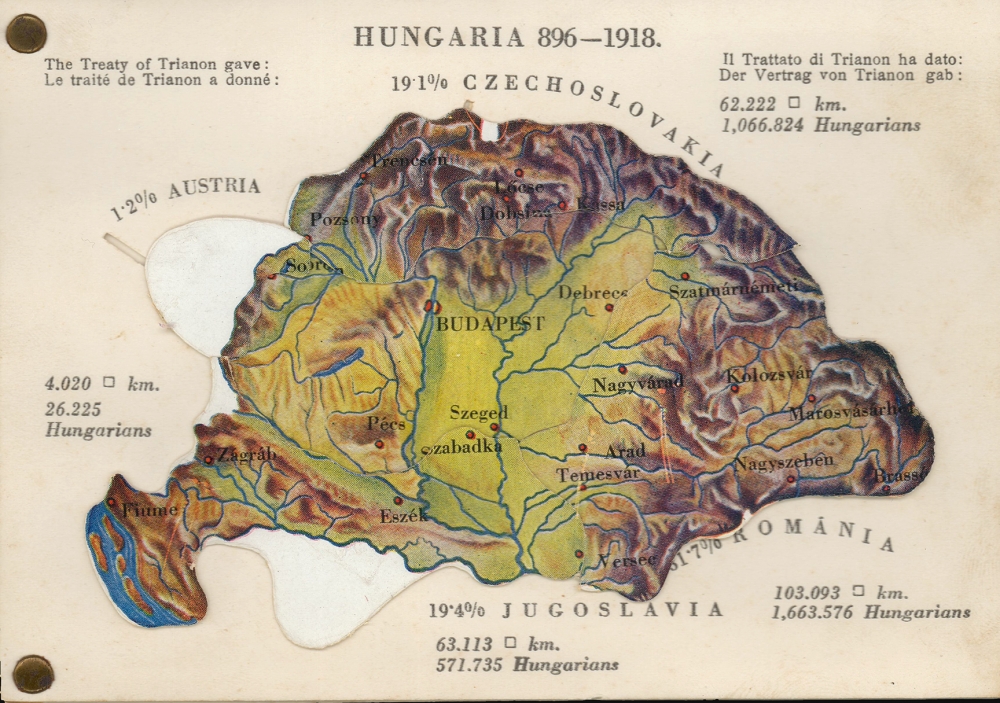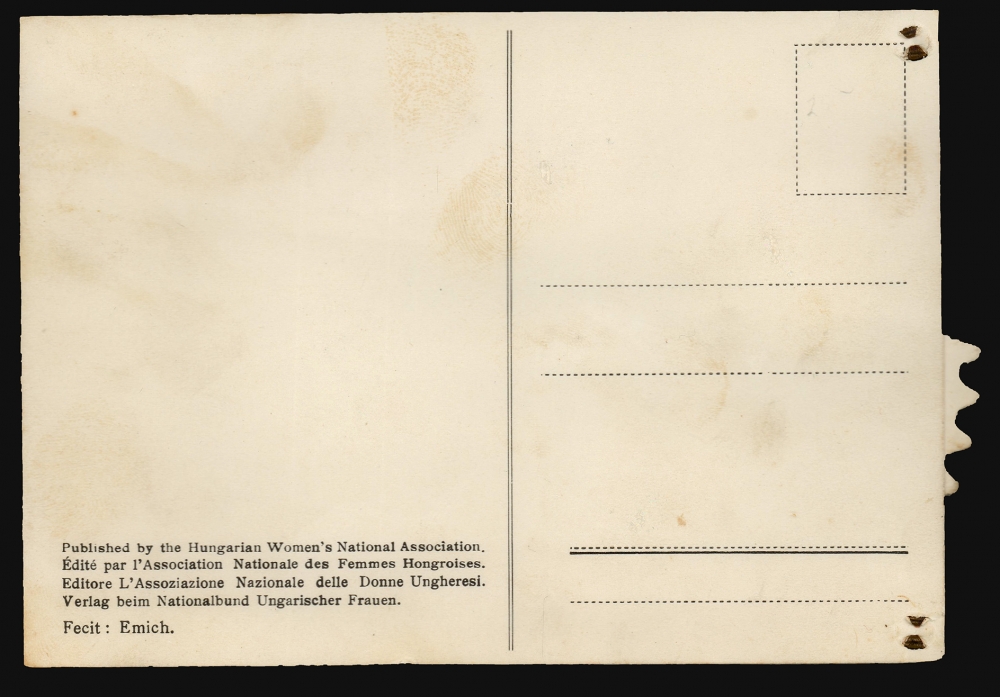This item has been sold, but you can get on the Waitlist to be notified if another example becomes available, or purchase a digital scan.
1920 Emich Irredentist Mechanical Map of Hungary
Hungary-emich-1920
Title
1920 (undated) 4 x 6 in (10.16 x 15.24 cm)
Description
The Deconstruction of Hungary
The punitive treaty, primarily engineered by France, defined Hungary's borders as those reflected in the 1918 cease-fire lines, with the result that Hungary lost two thirds of the territory it had occupied prior to the First World War, with 1.2% passing to Austria, 19.1% to Czechoslovakia, 19.4% to Yugoslavia, and 31.7% to Romania. The card also notes, for each lost piece of territory, the size of the ethnically Hungarian population alienated.This change in territory is illustrated on this card by the manipulation of a paper dial on the left side of the card: by moving the dial, the portions of pre-war Hungary move away from the remaining part in the center, illustrating dramatically the dissection of the country.
National Poem of the Horthy Era
The onionskin sleeve accompanying the card is printed, in six languages, with the poem Magyar Hiszekegy, written in 1920 by Elemérné Papp-Váry Szeréna Sziklay at the call for submissions by Magyarország Területi Épségének Védelm Ligája (the League for the Protection of the Territorial Construction of Hungary) for poems and prayers reflecting the goal of recapturing the parts of Hungary lost in the Treaty/ Dictate of Trianon. This three-line prayer would become the national prayer during the Horthy Era, the period from 1920 to 1946 in which Hungary was ruled by Regent Miklós Horthy. Characterized by its conservative, nationalist and fiercely anti-communist character, Horthy's government pressed for the total or partial revision of the Treaty of Trianon, capitalizing on a national resentment continuing until the present.Publication History and Census
This object is scarce: we see only four in institutional collections, dated 1920; we see one example in the trade speculatively dated c. 1934; the National Library of Scotland dates an example c. 1938. It was produced on behalf of the Hungarian Women's National Association; the mapmaker is given as Emich, which institutional cataloguers have taken to refer to Gusztáv Emich: a distinction less illuminating than one might think, as the name could as easily apply to Gusztáv Emich the 1920 minister of trade (1866 - 1927) as it could to his son, Gusztáv Emich (1897–1932.) The elder Emich's father Gusztáv (1843-1911) can be eliminated from our search, as can his father Gusztáv (1814-1869.) The 1920 minister of trade is nevertheless probably the best candidate: he did produce the 1920 'Magyarország gazdasági térképekben/ The economies of Hungary in maps', which mirrored the present document in its Irredentist sentiment.CartographerS
Emich Gusztáv (Nov. 3, 1866 - July 10, 1927) was a Hungarian trade minister and diplomat. He studied law and trade policy in Hungary, Germany and Paris. In 1888 he became an official in the Ministry of Agriculture, Industry and Trade. Starting in 1905, he represented the Hungarian government several times at foreign congresses. For many years, he served as the government commissioner of the Commodity and Stock Exchange in Budapest. In 1917, he was appointed secretary of state. Briefly in 1920 he was Minister of Trade in the Simonyi-Semadam government (the administration mainly notable for signing the Treaty of Trianon, by which Hungary lost 2/3 of its territory.) Qt that time, he oversaw the publication of the 1920 Magyarország gazdasági térképekben/ The economies of Hungary in maps. That year He was elected to the National Assembly in 1920, but resigned his mandate in September; he then served as ambassador to Berlin from 1920 to 1925. More by this mapmaker...
National Association of Hungarian Women (active 1918-1946) were a Hungarian women's Christian nationalist association formed at the end of the first world war and active during the Horthy era of Hungarian politics. They were active supporters of Miklós Horthy, and were proponents of Hungarian irredentism, engaged in such efforts as clothes drives for Hungarian minorities in the territories separated from Hungary by the Treaty of Trianon in 1920. In addition to international campaings concerning 'the Hungarian Question' The group also did social and child protection work, established colleges for female students, boarding schools for farm children, weaving colonies, and religious education for rural women. Their publicatioons included A Magyar Asszony (1921-1944), and the 1941 New Hungarian Woman Some of the organizations' leaders included members of the government, such as László Rajk, Minister of the Interior; so it can be surmised that they may have always been an arm of the Horthy government. Learn More...






